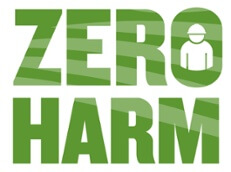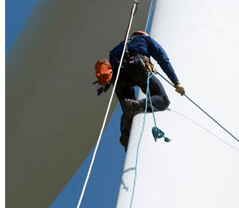
AWEA is dedicated to promoting and working toward a zero-harm work environment at wind sites.
If you’ve ever wondered just how safe the wind industry is you aren’t alone. The American Wind Energy Association’s (AWEA) Safety Committee was formed to help monitor and promote health and safety within the wind energy sector. But this isn’t always an easy task.
“I’ve been involved since it started and now, as the Chair of the Safety Steering Committee, I can tell you it is quite a broad undertaking,” shared Michael Kelley at AWEA’s annual Fall Symposium. He is also the Executive Director of Environmental Safety and Health for O&M provider UpWind Solutions. “Over the last six years at AWEA, we’ve developed guidance documents and white papers on confined spaces, dropped-object prevention, lockout and tagout issues, and more.”
Lock-out and tag-out (often referred to as LOTO) are just one example of a safety issue on a wind farm, and are procedures that an employee should take to guard against the unexpected release of hazardous energy from machinery during operations or maintenance.
Kelley said AWEA’s Safety Committee is comprised of nine sub-committees and four task forces. Each one of those sub-committees is working on relevant issues that affect the wind business such as siting, O&M, and overall worker and worksite safety.
“For example, we have one group dedicated to working on offshore wind at the moment to see what it’s going to take for the industry to push forward and fully get projects going in the U.S. — and completed in the safest manner possible,” he added.
The offshore sub-committee is currently reviewing related regulations that have come out of Europe to see what will and what won’t work here. “The European regulations serve as a base but not everything will translate well into U.S. waters,” explained Kelley. “So the sub-committee is going through each document and vetting it to see what best meets our own national electrical standards, coast guard rules, OSHA guidelines, and so on.”
OSHA, or the Occupational Safety and Health Administration, is a federal organization that helps ensure safe working conditions for Americans by enforcing safety standards. AWEA’s recommendations abide by those standards and, in some cases, seek to improve on them.
“Organizations such as OSHA often provide a standardized answer that doesn’t always fit in the wind industry. But AWEA has the ability to have inter-organizational discussions and explain what’s being done and explain why the general rules don’t always work for wind,” said Kelley, who suggests directing safety-related questions to AWEA rather than outside organizations.

One of the mandates of the AWEA Safety Committee is to serve as an information-sharing network on the key issues and policies that impact worker safety and health during construction and operation of wind farms.
AWEA’s Safety Committee also provides annual surveys to wind companies in hopes the answers will point toward what’s needed or lacking in the industry.
“We’re looking to get granular data that gives people a real understanding of what our safety numbers are like in wind, but to do so we need to collect that information from enough people in the industry,” said Kelley. “That isn’t always as easy as it sounds.”
According to Kelley, there are 300 participating companies and the best response they’ve gotten back so far is from 52 of those businesses. “The percentage there isn’t very good. Last year the response was a little below that at 48. But you have to understand that the sub-committees are formed based on the data obtained by the overall safety program. If we don’t have answers to our surveys, we don’t have much to work with.”
The data collected from these surveys are intended as a safety benchmark and the results provide a measure by which businesses and the industry can rank their own conduct. “People should have the correct data and the right to go back to their companies and explain whether they’re above or below typical safety numbers for the year, and find ways to improve if necessary. But to do so, we need to have people participate in our surveys,” he added.
So, why aren’t more companies involved and more people answering the questions? There are some concerns about security and legal issues, and others are concerned about anonymity, said Kelley. “It’s a mixed bag, really. But we’re not asking for information that anyone outside of a business or organization couldn’t ask for. I come from the oil and gas sector where transparency was never an issue. We talked about accident-incident reports and best-management practices without a second thought.”
He explained that openness is common in that industry mainly because of age and experience. “It’s had catastrophic accidents and deaths that have sadly killed hundreds of people. But one of the outcomes is that the oil and gas sector is well beyond privacy issues. It just wants to provide the safest working environments possible.”
AWEA’s Safety Committee is working toward a similar approach to transparency in the wind industry. “At the end of the day, we do our best when we share best-management practices,” said Kelley. He added that a common question they’re often asked is how the wind industry compares to others including oil and gas industries, in terms of safety.
“In most cases, people assume wind is unsafe. People go on the Internet and what do they find? All too often, it’s pictures of burning turbines. It’s really a misconception though, and a dangerous one at that.” He explained that if this is what organizations like OSHA seek and find, then it’s also likely what Congress will conclude because they rely on such regulatory groups to get much of their industry information.
“Providing accurate data on safety in the wind industry is much of what’s driving this Committee right now. We started the survey in 2010 and asked people to give us as much data as they can, some of which is dating back to 2008,” he said.
So what have they found so far? “If you look at construction, wind has a 1.2 TRIR or total recordable incident rate, and the overall construction industry has a 3.5 TRIR. A lower rate is better and we’re half of that! But we really don’t do a good job letting the industry and others know that. We’d like to do a better job because we really think this number is even lower.”
Incidence rates are a metric used to compare a company’s safety performance against the national average. Kelley went on to provide other figures including for manufacturing, which ranks at 4.79 TRIR. A primary sheet-metal manufacturing is at 4.8 TRIR. “Both numbers are high,” he admitted, “But wind isn’t really above the industry in this case. And if you look at O&M in power generation, the sector everyone wants to compare wind to, well they’re at 1.8 TRIR and wind is at 1.69 TRIR.”
While there is always room for improvement, what makes the incident numbers for wind even more impressive are the site conditions. “Generally, wind employees climb 300 feet in the air and back down again,” Kelley pointed out. “They take their skill set and apply it in a nacelle — a much more hazardous environment for the most part — and yet wind has a better incident rate than those working on the ground. But I don’t think everyone knows that.”
One of the mandates of the Safety Committee is to serve as an information-sharing network on the key issues and policies that impact worker safety and health during construction and operation of wind farms. Member participation facilitates this process and affects the changes that take place to create a safer work environment.
“So, please answer the questions and provide us with data when asked so that when we’re asked, ‘How safe is the wind industry?’” Kelley said, “We can answer loud and clear: we’re really safe.”
AWEA’s Safety Committee
Per AWEA’s website, the Safety Committee and its subcommittees, “Advise the AWEA Board and the broader industry on positions related to regulatory or legislative proceedings at the federal, state, or local level on the issue of worker safety and health.”
The committee is led by a steering committee that includes representatives from major sectors, such as wind owners and operators, turbine manufacturers, construction contractors, electrical contractors, third-party service providers, academics, safety consulting, and equipment providers.
The purpose and scope of AWEA’s Safety Committee is to:
- Promote safety and health within the wind industry;
- Achieve a safe workplace for all parties;
- Act as the health and safety spokespeople for the industry with OSHA;
- Provide a forum to exchange information on industry best practices, lessons learned and regulatory requirements; and
- Have all members actively participate in facilitating the Safety Committee’s work and continuous improvement.
Learn more at www.awea.org
Filed Under: News, Safety




